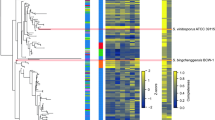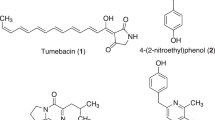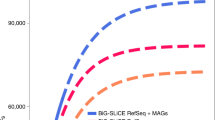Abstract
Streptomyces has the largest repertoire of natural product biosynthetic gene clusters (BGCs), yet developing a universal engineering strategy for each Streptomyces species is challenging. Given that some Streptomyces species have larger BGC repertoires than others, we proposed that a set of genes co-evolved with BGCs to support biosynthetic proficiency must exist in those strains, and that their identification may provide universal strategies to improve the productivity of other strains. We show here that genes co-evolved with natural product BGCs in Streptomyces can be identified by phylogenomics analysis. Among the 597 genes that co-evolved with polyketide BGCs, 11 genes in the ‘coenzyme’ category have been examined, including a gene cluster encoding for the cofactor pyrroloquinoline quinone. When the pqq gene cluster was engineered into 11 Streptomyces strains, it enhanced production of 16,385 metabolites, including 36 known natural products with up to 40-fold improvement and several activated silent gene clusters. This study provides an innovative engineering strategy for improving polyketide production and finding previously unidentified BGCs.
This is a preview of subscription content, access via your institution
Access options
Access Nature and 54 other Nature Portfolio journals
Get Nature+, our best-value online-access subscription
$29.99 / 30 days
cancel any time
Subscribe to this journal
Receive 12 digital issues and online access to articles
$119.00 per year
only $9.92 per issue
Buy this article
- Purchase on Springer Link
- Instant access to full article PDF
Prices may be subject to local taxes which are calculated during checkout






Similar content being viewed by others
Data availability
The transcriptomic data of S. griseus and S. rapamycinicus are available at NCBI GEO database (GSE256209). The mass spectrometry proteomics data are available at the ProteomeXchange Consortium via the iProX repository (PXD049454). Other data supporting the findings of this study are included in the published article and Supplementary Information. Requests for any additional information can be made to the corresponding authors. Source data are provided with this paper.
Code availability
The code of pan-genomic analysis was described in the Methods section of the paper. All the code is openly available in GitHub.
References
Newman, D. J. & Cragg, G. M. Natural products as sources of new drugs over the nearly four decades from 01/1981 to 09/2019. J. Nat. Prod. 83, 770–803 (2020).
Li, S., Li, Z., Pang, S., Xiang, W. & Wang, W. Coordinating precursor supply for pharmaceutical polyketide production in Streptomyces. Curr. Opin. Biotechnol. 69, 26–34 (2021).
Wang, W. et al. Harnessing the intracellular triacylglycerols for titer improvement of polyketides in Streptomyces. Nat. Biotechnol. 38, 76–83 (2020).
Liu, G., Chater, K. F., Chandra, G., Niu, G. & Tan, H. Molecular regulation of antibiotic biosynthesis in Streptomyces. Microbiol. Mol. Biol. Rev. 77, 112–143 (2013).
Gavriilidou, A. et al. Compendium of specialized metabolite biosynthetic diversity encoded in bacterial genomes. Nat. Microbiol. 7, 726–735 (2022).
Gao, L. et al. The tomato pan-genome uncovers new genes and a rare allele regulating fruit flavor. Nat. Genet. 51, 1044–1051 (2019).
de Vries, R. P. et al. Comparative genomics reveals high biological diversity and specific adaptations in the industrially and medically important fungal genus Aspergillus. Genome Biol. 18, 28 (2017).
Cruz-Morales, P. et al. Revisiting the evolution and taxonomy of Clostridia, a phylogenomic update. Genome Biol. Evol. 11, 2035–2044 (2019).
Chandra, G. & Chater, K. F. Developmental biology of Streptomyces from the perspective of 100 actinobacterial genome sequences. FEMS Microbiol. Rev. 38, 345–379 (2014).
Schoch, C. L. et al. NCBI Taxonomy: a comprehensive update on curation, resources and tools. Database https://doi.org/10.1093/database/baaa062 (2020).
Bentley, S. D. et al. Complete genome sequence of the model actinomycete Streptomyces coelicolor A3(2). Nature 417, 141–147 (2002).
Kim, J. N. et al. Comparative genomics reveals the core and accessory genomes of Streptomyces species. J. Microbiol. Biotechnol. 25, 1599–1605 (2015).
Bu, Q. T. et al. Comprehensive dissection of dispensable genomic regions in Streptomyces based on comparative analysis approach. Micro. Cell Fact. 19, 99 (2020).
Zhou, Z., Gu, J., Li, Y. Q. & Wang, Y. Genome plasticity and systems evolution in Streptomyces. BMC Bioinf. 13, S8 (2012).
Belknap, K. C., Park, C. J., Barth, B. M. & Andam, C. P. Genome mining of biosynthetic and chemotherapeutic gene clusters in Streptomyces bacteria. Sci. Rep. 10, 2003 (2020).
Zaburannyi, N., Rabyk, M., Ostash, B., Fedorenko, V. & Luzhetskyy, A. Insights into naturally minimised Streptomyces albus J1074 genome. BMC Genom. 15, 97 (2014).
Chung, Y. H. et al. Comparative genomics reveals a remarkable biosynthetic potential of the Streptomyces phylogenetic lineage associated with rugose-ornamented spores. mSystems 6, e0048921 (2021).
Jonscher, K. R., Chowanadisai, W. & Rucker, R. B. Pyrroloquinoline-quinone is more than an antioxidant: a vitamin-like accessory factor important in health and disease prevention. Biomolecules 11, 1441 (2021).
Wagh, J., Shah, S., Bhandari, P., Archana, G. & Kumar, G. N. Heterologous expression of pyrroloquinoline quinone (PQQ) gene cluster confers mineral phosphate solubilization ability to Herbaspirillum seropedicae Z67. Appl. Microbiol. Biotechnol. 98, 5117–5129 (2014).
Zhu, W. & Klinman, J. P. Biogenesis of the peptide-derived redox cofactor pyrroloquinoline quinone. Curr. Opin. Chem. Biol. 59, 93–103 (2020).
Shen, Y. Q. et al. Distribution and properties of the genes encoding the biosynthesis of the bacterial cofactor, pyrroloquinoline quinone. Biochemistry 51, 2265–2275 (2012).
Yamauchi, Y. et al. Quinoprotein dehydrogenase functions at the final oxidation step of lankacidin biosynthesis in Streptomyces rochei 7434AN4. J. Biosci. Bioeng. 126, 145–152 (2018).
Cruz-Morales, P. et al. Biosynthesis of polycyclopropanated high energy biofuels. Joule 6, 1590–1605 (2022).
Moumbock, A. F. A. et al. StreptomeDB 3.0: an updated compendium of streptomycetes natural products. Nucleic Acids Res. 49, D600–D604 (2021).
Olano, C. et al. Activation and identification of five clusters for secondary metabolites in Streptomyces albus J1074. Microb. Biotechnol. 7, 242–256 (2014).
Xu, F., Nazari, B., Moon, K., Bushin, L. B. & Seyedsayamdost, M. R. Discovery of a cryptic antifungal compound from Streptomyces albus J1074 using high-throughput elicitor screens. J. Am. Chem. Soc. 139, 9203–9212 (2017).
Beganovic, S. et al. Systems biology of industrial oxytetracycline production in Streptomyces rimosus: the secrets of a mutagenized hyperproducer. Microb. Cell Fact. 22, 222 (2023).
Abbate, E. et al. Optimizing the strain engineering process for industrial-scale production of bio-based molecules. J. Ind. Microbiol. Biotechnol. 50, kuad025 (2023).
Sun, F., Xu, S., Jiang, F. & Liu, W. Genomic-driven discovery of an amidinohydrolase involved in the biosynthesis of mediomycin A. Appl. Microbiol. Biotechnol. 102, 2225–2234 (2018).
Whitford, C. M., Cruz-Morales, P., Keasling, J. D. & Weber, T. The design-build-test-learn cycle for metabolic engineering of Streptomycetes. Essays Biochem. 65, 261–275 (2021).
Chen, X. et al. A new bacterial tRNA enhances antibiotic production in Streptomyces by circumventing inefficient wobble base-pairing. Nucleic Acids Res. 50, 7084–7096 (2022).
Gessner, A. et al. Changing biosynthetic profiles by expressing bldA in Streptomyces strains. Chem. Bio. Chem. 16, 2244–2252 (2015).
Tsunematsu, Y. et al. Distinct mechanisms for spiro-carbon formation reveal biosynthetic pathway crosstalk. Nat. Chem. Biol. 9, 818–825 (2013).
Saihara, K., Kamikubo, R., Ikemoto, K., Uchida, K. & Akagawa, M. Pyrroloquinoline quinone, a redox-active o-quinone, stimulates mitochondrial biogenesis by activating the SIRT1/PGC-1alpha signaling pathway. Biochemistry 56, 6615–6625 (2017).
Simao, F. A., Waterhouse, R. M., Ioannidis, P., Kriventseva, E. V. & Zdobnov, E. M. BUSCO: assessing genome assembly and annotation completeness with single-copy orthologs. Bioinformatics 31, 3210–3212 (2015).
Chaudhari, N. M., Gupta, V. K. & Dutta, C. BPGA—an ultra-fast pan-genome analysis pipeline. Sci. Rep. 6, 24373 (2016).
Minh, B. Q. et al. IQ-TREE 2: new models and efficient methods for phylogenetic inference in the genomic era. Mol. Biol. Evol. 37, 1530–1534 (2020).
Blin, K. et al. antiSMASH 6.0: improving cluster detection and comparison capabilities. Nucleic Acids Res. 49, W29–W35 (2021).
Komaki, H. & Tamura, T. Reclassification of Streptomyces cinnamonensis as a later heterotypic synonym of Streptomyces virginiae. Int. J. Syst. Evol. Microbiol. 71, 004813 (2021).
Wang, X. R., Wang, R. F., Kang, Q. J. & Bai, L. Q. The antitumor agent ansamitocin P-3 binds to cell division protein FtsZ in Actinosynnema pretiosum. Biomolecules 10, 699 (2020).
Wu, M. et al. Phosphoproteomics reveals novel targets and phosphoprotein networks in cell cycle mediated by Dsk1 kinase. J. Proteome Res. 19, 1776–1787 (2020).
Zhao, Y., Xiang, S., Dai, X. & Yang, K. A simplified diphenylamine colorimetric method for growth quantification. Appl. Microbiol. Biotechnol. 97, 5069–5077 (2013).
Nanchen, A., Fuhrer, T. & Sauer, U. Determination of Metabolic Flux Ratios From 13C-Experiments and Gas Chromatography-Mass Spectrometry Data (Humana, 2007).
Acknowledgements
We acknowledge the financial support provided by National Key R&D Program of China (to X.L., grant no. 2018YFA0903200), National Natural Science Foundation of China (to X.L., grant no. 32071421 and to H.D., grant no. 32201203), Shenzhen Science and Technology Program (to X.L., grant nos. ZDSYS20210623091810032 and RCYX20200714114736026), China Postdoctoral Science Foundation (to X.W., grant no. 31800023), Shenzhen Medical Research Fund (to X.W., grant no. D2301005), Shenzhen Science and Technology Program (to X.W., grant no. JCYJ20220531100207017), Shenzhen Bay Scholar Fellowship (to X.L. and X.T., grant no. 229100002), Novo Nordisk Foundation (to P.C.-M., grant no. CFB 2.0, NNF20CC0035580), which made this research possible. We thank J. Nikodinovic-Runic for kindly providing the strain Streptomyces sp. NP10, G. Liu, F. Ni and L. Zhou for help in industrial strains experiments, M. Wu for technique support on proteomics analysis, H. He and G. Zhang for project discussion and Z. Wei for meeting organization for this project.
Author information
Authors and Affiliations
Contributions
X.W., P.C.-M., X.T., J.D.K. and X.L. conceived and supervised the project. X.W. and N.C. designed and performed the main experiments. P.C.-M. and S.A. performed the bioinformatics analysis. Y.S., L.B., J.W., Y.X. and X.F. designed and participated in the industry strain experiments. X.T. and Y.L. designed and participated in the bioassay test. B.Z. participated in the metabolomics analysis. Y.Z. participated in RNA sequencing data analysis. Z.L. and H.D. participated in fermentation data analysis. X.W., P.C.-M., J.D.K. and X.L. wrote and revised the paper.
Corresponding authors
Ethics declarations
Competing interests
J.D.K. has financial interests in Amyris, Ansa Biotechnologies, Apertor Pharma, Berkeley Yeast, Cyklos Materials, Demetrix, Lygos, Napigen, ResVita Bio and Zero Acre Farms. X.L. has financial interests in Demetrix and Synceres. The other authors declare no competing interests.
Peer review
Peer review information
Nature Metabolism thanks Kenji Arakawa, Hyun Uk Kim and Lixin Zhang for their contribution to the peer review of this work. Primary Handling Editor: Alfredo Giménez-Cassina, in collaboration with the Nature Metabolism team.
Additional information
Publisher’s note Springer Nature remains neutral with regard to jurisdictional claims in published maps and institutional affiliations.
Supplementary information
Supplementary Information
Supplementary Materials and Methods, Tables 1–14 and Figs. 1–18.
Supplementary Data 1–7
1. Information of selected 720 actinobacterial genomes. 2. 604 orthologous proteins shared by 201 Streptomyces. 3. Information of the 597 unique proteins. 4. Presence or absence of each unique gene in the 201 genomes. Correlation of each unique gene with PKS proficiency. 5. Upregulated proteins after pqq operon introduction in S. coelicolor. 6. Change of various precursors after pqq operon introduction in S. coelicolor. 7. Change of all metabolites after pqq operon introduction in different Streptomyces.
Source data
Source Data Figs. 1–6
Statistical source data.
Rights and permissions
Springer Nature or its licensor (e.g. a society or other partner) holds exclusive rights to this article under a publishing agreement with the author(s) or other rightsholder(s); author self-archiving of the accepted manuscript version of this article is solely governed by the terms of such publishing agreement and applicable law.
About this article
Cite this article
Wang, X., Chen, N., Cruz-Morales, P. et al. Elucidation of genes enhancing natural product biosynthesis through co-evolution analysis. Nat Metab (2024). https://doi.org/10.1038/s42255-024-01024-9
Received:
Accepted:
Published:
DOI: https://doi.org/10.1038/s42255-024-01024-9



